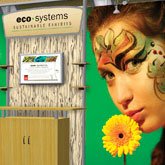Displays of Affection: Trade Show Booths Go Earth-Friendly
Trade shows are getting a little less wasteful thanks to Eco Systems Displays. The Grand Rapids, Mich.–based company has developed eco-friendly booths and displays made from recycled and sustainable resources.
Now, if everyone would just recycle their plastic bottles.
The California Apparel News spoke with founder Tim Morris, who’s spent 20 years in the exhibit industry, about his new company and how to quantify “greenliness” when it comes to trade-show booths.
CAN: How did Eco Systems Displays come about?TM: In 2005, a client for one of my other businesses, Exhibit Design Consultants (exhibit-design.com) asked us to produce a “green” exhibit booth. We’d been hearing about green in the media but really didn’t know what it meant. So we began researching and came up with materials, processes, adhesives, stains, finishes, paints, and all that.
“Green” is thrown around very easily, and for us to produce this exhibit for our client, we needed more of a benchmark to hit as opposed to just saying it’s green.
CAN: How did you go about quantifying “greenliness”?TM: We did a lot of research online, networked in the trade-show industry, and came up with an exhibit that was 20 feet deep and 60 feet long. In 2006, our client took it to Neocon, which is the office furniture–industry trade show.
We found materials that, according to the supplier, were affiliated with the U.S. Greenbuild Council and were accredited according to energy and environmental design benchmarks. We went off of third parties’ benchmarks to create the display, which was environmentally responsible, or “green.”
CAN: What materials did you use?TM: We used bamboo for the floor; wheatboard, which is made from a wheat byproduct; recycled-glass countertops; biodegradable carpet—just a number of materials we had to go out and find for this exhibit.
At Neocon, I had an exhibitor come up to me and say, “The whole sustainability concept is really important to us.” Then I looked at their exhibit and saw the use of PVC and chrome-plated this and that. I said, “Your exhibit isn’t that sustainable,” and she said, “Then why don’t you make them for us.” And that’s how Eco Systems Displays began.
CAN: Trade shows are apparently a terribly wasteful enterprise.TM: Yes, in fact some studies rate the tradeshow industry as the second-largest trash-producing industry behind construction and demolition.
CAN: What are the main reasons for that, and how do you seek to counter it?TM: There are definitely manufacturers of disposable booths, but it’s a combination of the waste that occurs from packaging, literature that doesn’t get handed out, and right down to the exhibits, which you tend to throw in the dump.
We have a recycling program called Reincarnation that allows the client to properly recycle their exhibit from the wood and metal nails right down to the copper wire in the light fixtures. So we’re trying to stem that tide from the design-and-build side from the old exhibits. For the new ones, we’re producing ones built from materials that have a high level of recycled content, that are rapidly renewable, and certainly recyclable.
And the people who build these exhibits are people who typically have trouble re-entering society. Some of our employees are reforming felons who can’t find a job, and we employ them to help them get their lives together.
CAN: How do people order a display from you?TM: We sell through display houses across the country. Call us and we’ll refer you to your local distributor that’s certified in the ability to sell our product. For the Western U.S., we manufacture in Portland, Oregon.
CAN: What is the price range?TM: Originally it started out as much as 25 percent more than traditional. We’re down to about 8 percent now.
We have exhibits that start around $1,200 all the way up to a couple hundred thousand dollars.
CAN: What do you get for $1,200?TM: You get a portable display that’s about 5 feet by 5 feet and sits on top of a table. It has Velcro-compatible fabric panels [for hanging graphics] that are made from recycled plastic from soda bottles. You can buy a similar product that’s not sustainable for most of that cost, but all of our displays significantly lower the carbon footprint of the end user.
For instance, we use recycled plastic material for the panels, recycled soda-bottle material for the Velcro fabric. In the traditional world, you’d be using PVC in conjunction with a polyester and nylon-blend material and potentially petroleum-based adhesive. There’s nothing very environmentally responsible about any of that.
CAN: You mentioned that many companies throw away their exhibits. Is there a way to recoup the cost of an exhibit, by reselling or recycling, if a company upgrades to a larger one?TM: Absolutely. All the exhibit materials we reclaim find their way into an aftermarket application. There’s a cost to that, and it’s generally more costly than if you were to throw it in the dumpster.
But the people who buy our products are more concerned with the bigger picture.
CAN: But what about making money back from a booth rather than spending money to dispose of it?TM: That’s a good question. Typically, the more aluminum and copper you have in the exhibit, the better the chance you’ll find it to be cash-positive. The expense is in the labor to break it down to where a recycler can do something with it.
CAN: You mentioned earlier that the term “green” is very vague, and it sounds like you’ve taken steps to ensure what you do can be quantifiably measured for its ecofriendliness.TM: Exactly. I play an active role helping the exhibit industry set its own benchmarks so it knows what green means. It’s a long process, and we’re very early in it, but by the end of 2008 we’ll be kicking off that standard through the Exhibit Designer Producer Association.
CAN: How are those in the trade-show industry responding, especially knowing how wasteful the enterprise is?TM: Even the people in our industry who don’t believe in global warming, when they hear about the amount of waste we produce, they’re surprised. It’s not a big surprise; they can understand it. And I think everyone’s ashamed of it. It’s not anything you want to hang your hat on, no matter how you feel about the environment, when you find out the amount of waste we create.
But I think many are willing to do something about it, and that’s very encouraging.
CAN: What’s some of the feedback you’re getting?TM: We hear from end users that they’re interested in our product because they feel it bodes well for their company image. Certainly our sweet spot is with people who embrace sustainability and who have policies and benchmarks within their company.
We’ve had very few obstacles in our way as we roll out our product across the country.
It’s been heart-warming when our distributors are excited about leading with our product and spreading the religion that we want to preach in our industry.
CAN: How have your sales been?TM: It started quite slow. When we launched, we didn’t really know how it was going to be received, so it was hard to plan.
But we received the Buyer’s Choice Award at the Trade Show Exhibitor’s Association show, and we walked away with such a huge number of leads that we knew it was going to be a big hit. We’re very happy with where we are, and we’re certainly ahead of where we thought we’d be.
CAN: What are Europe and Asia like when it comes to green, and do you expect to enter those markets?TM: In mainstream society, they’re very much ahead. On the trade-show side, I’m have a hard time finding information in Europe about how sustainable products can be purchased in the trade-show and event industry.
Normally Europe drives our industry from the design side, but we’re just not finding it from an environmental side.
CAN: What’s in the future for you?TM: We have quite a bit on the R&D burner that revolves around changing the materials we use. We’re close on a replacement for aluminum, which is a very energy-intense, very pollution-based material that is overused in our industry. Come this next year we’ve got some exciting stuff coming out that will certainly change the dynamic in our industry.


























